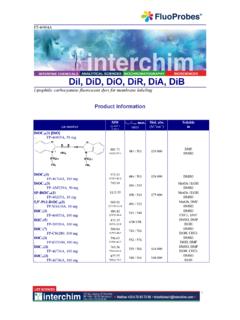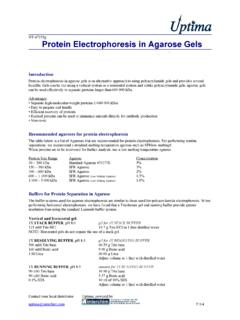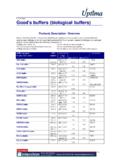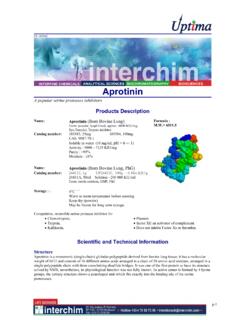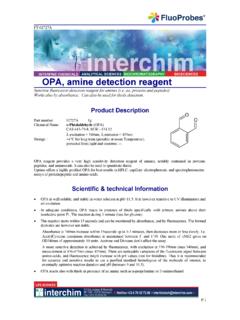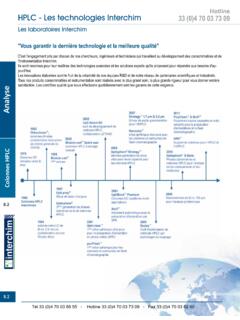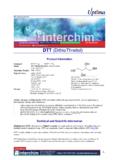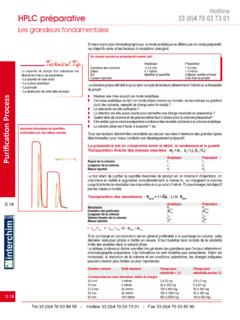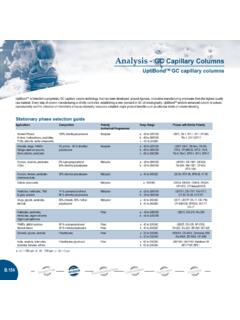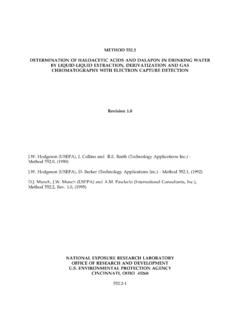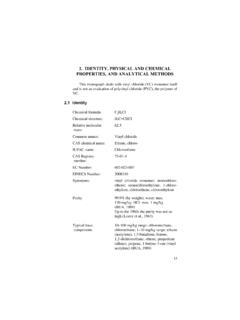Transcription of FT-01566H Quantitation of sulfhydryls DTNB, Ellman’s reagent
1 FT-01566H For any question, contact your local distributor at Uptima, powered by Hotline : +33(0)4 70 03 76 06; Quantitation of sulfhydryls DTNB, ellman s reagent Products Description Colorimetric assay reagents for thiols Catalog number: UP01566H, 1g UP01566H, 5g Name: DTNB ( ellman s reagent ) 5,5'-Dithio-bis (2-nitrobenzoic acid) Physical data: CAS: [69-78-3], Appearance: yellow crystals or powder Purity: Storage: Store cold. Keep dry.(K) Warm to room temperature before opening Catalog number: RS0810 , 10mg Name: ADTNB 5-(2-Aminoethyl)Dithio-2-Nitrobenzoic Acid Physical data: CAS: [71899-86-0], Appearance: pale yellow powder Soluble in water Storage: Store cold.
2 Keep dry.(K) Warm to room temperature before opening To be used with: UP04901V acetyl-Cysteine, UltraPure (standard for DTNB assay) CAS: [616-91-1], Storage: Room temperature.(Z) DTNB has been popularized for assaying free thiols. ADTNB reacts with free thiols in a similar manner to ellman s reagent , but with dramatically improved stability. Directions for use Protocol 1. ellman 's Test: Quantitative Determination of Peptides by Sulfhydryl (-SH) Groups ( ellman 1959, Bulaj 1998). This is the standard ellman s Test for the determination of free thiols ( ellman 1959). It works well for small peptides and proteins synthesized using standard solid phase synthetic methods.
3 Peptides from these syntheses are usually in their reduced form, and are usually stable to oxidation in acidic solutions. Free thiol can be determined in solutions collected from chromatographic separations or from reconstituted lyophilized samples. This protocol has been used for peptides (3 to 26mer) with a single Cys residue present and lacking tryptophan. (Bulaj 1998, Horn). The technique should be feasible for multiple Cys residues. 1) Prepare the DTNB stock solution and the Tris dilution buffer: DTNB solution: 50 mM sodium acetate (NaAc), 2 mM DTNB in H2O . Keep refrigerated. FT-01566H For any question, contact your local distributor at Uptima, powered by Hotline : +33(0)4 70 03 76 06; Tris solution: 1 M Tris / pH Keep refrigerated.
4 Prepare eventually a Standard SH (acetyl Cysteine) calibration curve, starting with 10mM concentration. 2) Prepare the DTNB working reagent : (per sample) add 50 L of the DTNB solution, 100 L Tris solution, and water 840 L (final volume will be 1000 l with 10 l sample) 3) Mix the solution carefully using a pipette. Place the cuvette into a UV spectrophotometer and measure the background. 4) Add 10 l sample solution (or 10 l sample buffer or water for the blank test, or 10 l of standards) to 990 l DTNB reagent . 5) Mix well and incubate 5min at room temperature 6) Measure the Optical Absorbance at 412 nm 7) Calculate SH content: method1: Divide OD412nm by the extinction coefficient of the DTNB (13 600 M-1cm-1) to get the molarity in the assay, and multiply by total volume/sample volume ratio (1000 L/10 L=100 for the standard protocol) of the solution!
5 SH concentration(sample) = (Tot. vol.) x OD412nm / 13 600 = 100 x OD412nm / 13 600 method2: Plot a calibration curve of ODs as function of standard (acetylCysteine) concentrations, and estimate SH concentration from sample ODs. Protocol 2. Determination of total sulfhydryl groups, protein-bound sulfhydryl groups, and free sulfhydryl groups in biological samples using DTNB ( ellman 's reagent ). Sensitivity 50 M to 1000 M. (Sedlak 1968) Total SH determination 1- Prepare the dilution buffer (30mM Tris HCl, 3mM EDTA ). Store at +4 C. Dissolve in 800 ml distilled H2O. Adjust pH with 3 N HCl to Add distilled H2O to make 1000 ml. 2- Prepare DTNB working solution.
6 Store at +4 C. Dissolve of DTNB in 25 ml Methanol. 3-Prepare a set of SH standard (acetylCystein) with sample dilution buffer (or distilled water). Dissolve acetylCystein at 1000 M, then serial dilutions down to 31 M. To be use immediately 3-Add the following components to test tubes: 20 l Sample/Standard 75 l dilution buffer 25 l DTNB reagent 400 l Methanol Spin down samples at 3000 x g for 5 min at room temperature. Using a multichannel pipettor, transfer 3 x 90 l supernatant into a flat-bottom microplate. 4-Measure the optical absorbance extinction at 412 nm. Free SH / bound SH A-Free SH (cystein, ) present in proteous samples should be separated from protein bound sulfhydryls .
7 As conventional desalting methods (desalting, gelfiltration) may affect SH content (by air oxidation), Uptima recommends to remove proteins from buffer, by a TCA precipitation method, prior to SH Quantitation . 1-Mix 50 l Sample or Standard or Blank + 2 x 25 l TCA 2-Spin down for 15 min at 1500 rpm and room temperature and keep the supernatant for later use. B-Set up the following reaction in a flat-bottom microplate: 1-Preparare reagents: FT-01566H For any question, contact your local distributor at Uptima, powered by Hotline : +33(0)4 70 03 76 06; pH 8,9: Dissolve48,44 g of Tris Base (final : 262 mM) and 8,32 g of EDTA (final : 13 mM) in 800 ml MilliQ.
8 Adjust pH with 3 N Hcl to 8,9. Add MilliQ to make 1000 ml. Store at room temperature. DTNB Solution150 M final: Dissolve 29,78 mg of DTNB in 25 ml Methanol. Store at 4 C. 2-Mix: 200 l Tris HCl 262mM EDTA 13mM pH 20 l DTNB 150 M Solution 50 l Sample supernatant from the TCA precipitation 3-Measure optical absorbancy at 412 nm. 4-Calculate the difference of the Total-SH and the Free SH. References DTNB #01566: Almoazen H. et al., Stability of Mesna in ReadyMed Infusion Devices, Ann. Pharmacother., 44: 224 - 225 (2010) Article Sedlak J. et al. Anal. Biochem. 25:192-205 (1968) ellman G. L. Arch. Biochem. Biophys. 82, 70-77.
9 (Original determination) (1959) Bulaj G.; et al. Biochemistry 37, 8965-8972. (Recent usage) (1998) References ADTNB #RS081: Zhang, H., et al.: Bioorg. Chem., 26, 356 (1998), Chen, Y., et al.: Biochem., 43, 11491 (2004) Additional information DTNB #01566 Melting point: 240 - 245 C; Isoelectric point: pI = Stable. Incompatible with strong bases, strong oxidizing agents. Toxicology: Skin, eye and respiratory irritant. May be harmful - toxicology not fully investigated. Toxicity data : IPR-MUS LD50 2080 mg kg-1 Risk phrases : R36 R37 R38. Transport information: Non-hazardous for air, sea and road freight. Personal protection: Safety glasses, adequate ventilation.
10 Safety phrases : S26 S36. Related documents and products See BioSciences Innovations catalogue and e-search tool. Other derivatization reagents: 1,8-Diazafluoren-9-one #HH6521 : Fluorescent derivatization of amino-acids ( ~470/~570 nm) Ninhydrin #024400: Fluorescent derivatization of amino-acids NBD-F # FP-U0573A: labeling of amines (aliphatic, aa, peptides, proteins) NHS ester of conventional fluorophores (coumarin, fluorescein, based) NHS ester of our great FluoProbes labels: labeling agents for amines OPA #02727A: amine and sulfhydryl assay reagent ABD-F #FP-57564A: labeling of thiols (30times faster than SBD-F; ideal for TLC, HPLC) SFB-F #FP-AM859A and SFB-Cl #FP-AM858A: labeling of thiols, widely used for chromatography DMEQ-COCl #FP-69129A: labeling of primary and secondary alcohols APTS #FP-33972A: labeling of aldehyde and ketones (of glycoproteins or sugars) for HR CE ANTS #FP-46574A: labeling of aldehyde and ketones (of glycoproteins or sugars) for sequencing and CE 4 NBA #BL9650, 2HP #O19022, 2 SBA #A42050: reagents to assay and block aldehydes and hydrazine DNP #015160: reagent for the determination of aldehydes and ketones
